Overview
- The Problem
- Tools, Skills And Parts
- Removing Exhaust System
- Removing Catalytic Converter
- Removing Driveshaft
- Removing Gearbox
- Removing Engine
- Tightening Torques
The Problem
The problem will occur sooner or later, your car starts to
leak oil due to bad seals. There are numerous places where
you can have oil leakage so it is important that you first
do a thorough investigation where exactly the oil is coming
from in the first place.
In my case it was easily verified the rear crankshaft oil
seal was leaking (oil was leaking out in the narrow opening
between engine and gearbox). To fix this you must remove the
gearbox. But I also had oil leakage between the engine block
and the oil pan. A new gasket was obviously needed. This
can be done without remove the engine (but you have to raise
it quite a bit). But I also found out that oil was leaking
from the back of the engine, against the firewall. So I
realized that it would be best to lift out the engine and
fix all seals and gaskets once and for all.
Tools, Skills And Parts
The job is time consuming, requires a lot of different
tools and have some few tricky parts. As in every job
everything can happen and since this job contains a lot
of different tasks, Murphy's law will apply and convert
a simple task into a nightmare. But to summarize, if you
don't are under time pressure the job will go just fine.
Difficulty Level




The following tools are required for this particular work (tools marked with
green checkmark are optional).
 | ratchet wrench | |
 | box-end wrench (13 mm) | |
 | box-end wrench (17 mm) | |
 | box-end wrench (19 mm) | |
 | 8 mm socket | |
 | 10 mm socket | |
 | 12 mm socket (6-point) | |
 | 13 mm socket | |
 | 19 mm socket (6-point) | |
 | socket extension bar (250 mm) | |
 | breaker bar (380 mm) | |
 | breaker bar (460 mm) | |
 | ATF oil | |
The following spare parts are required for this particular work. Note
that the BMW internal numbers are intended for a BMW 535i E34 -89.
 | rear silence bracket (2 pcs) | 18 21 1 178 340 | 105 SEK |
 | bow (2 pcs) | 18 21 1 178 343 | 44 SEK |
 | collar nut (2 pcs) | 07 11 9 927 022 | 8 SEK |
 | rubber ring (2 pcs) | 18 21 1 712 838 | 80 SEK |
Removing Exhaust System
The first step is to disconnect the two pipes connecting the catalytic converter
and the center muffler. Each pipe is connected using two flanges held together
with two 13 mm hex head nuts and two 13 mm hex head 8.8 grade screws.
Use for example two 13 mm box-end wrenches (or one 13 mm box-end wrench and 13 mm
socket on a ratchet wrench) and remove all four nuts and screws. The flanges can not
be removed so leave them on the pipes.
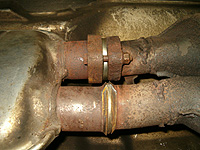
Connection between catalytic converter (to the right) and center muffler (to the left).
Support and raise the center muffler with a jack. Raise the center muffler a couple
of centimeters until the two rubber rings are hanging loosely. You can see the location
of these rubber rings in the upper right corner in the picture below. Now disconnect the
rubber rings from the chassi mounting point (and leave them attached on the exhaust
system). Try lubricate with some ATF oil (this type of oil is not aggresive against
rubber which ordinary engine oil are) around the rubber ring and the chassi mounting
point if you have problems.
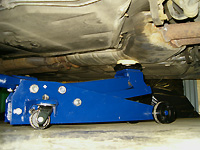
The center muffler supported and raised by a jack.
Now support the rear muffler with a jack. The rear muffler is mounted using a bracket
on each side. The right bracket is easy to access while the left bracket is more difficult
due to the rear spoiler.
If the brackets have been there for more than a couple of years, I strongly recommend
to cut the rubber ring (just above the lower bracket) instead. Then go and buy new
rubber rings and brackets. It's worth it! (The cost is only about 237 SEK).
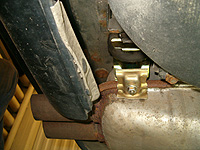
The right rear muffler bracket held together with a 13 mm hex head collar nut.
Remove the 13 mm hex head collar nut holding the bracket together. Remove the nut and
the lower part of the bracket completely. After you have removed both brackets the
exhaust system will now rest on the two jacks.
|
Pull the entire exhaust system backwards a couple of centimeters so the pipes of the
catalytic converter and the center muffler will be separated. Probably the 47 mm gasket
ring for the left pipe (and maybe the 50 mm gasket ring for the right pipe) will fall
down on the floor. When the pipes are completely separated you can lower the front jack
(the one supporting the center muffler). Place a jack stand to support the catalytic
converter. Next push the entire exhaust system forwards. Now you should be able to lower
the rear jack (the one supporting the rear muffler) without being blocked by the rear
spoiler. Finally lower both jacks and store that big package in a suitable place!

The exhasut system (consisting of center and rear muffler) removed.
Removing Catalytic Converter
The last thing to do to get full access to the driveshaft is to remove the
catalytic converter together with the front exhaust pipes.
Start by removing the two plastic covers located under the front of the car. It's
the "engine compartment screening" and the "air guide" (only for those with manual
transmission). The "engine compartment screening" is attached to the chassi with four
10 mm hex head plastic nuts and the "air guide" with four 10 mm hex head screws.
Next remove the metal heat shield covering the idler arm located just above the
right side of the front subframe. It is mounted with two 10 mm hex head screws.
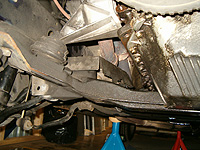
The metal heat shield covering the idler arm.
Locate the lambda sensor on the catalytic converter and follow the cable until
you find a connector (on the left side of the engine). Simply unscrew and disconnect.
Undo the cable from the clip near the connector.
Go back under the car and unscrew the thin metal shield protecting the lambda sensor
cable (fastened with two 10 mm hex head plastic nuts). Also undo the cable from the clip
near the catalytic converter. Roll together the cable and put it for example on top of the
catalytic converter.
Do not try to remove the lambda sensor if you not are planning to replace it. It can
be very difficult to loosen it, especially before you have removed it from the car.
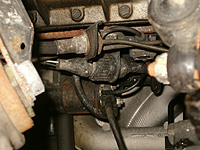
The lambda sensor connector on the left side of the engine.
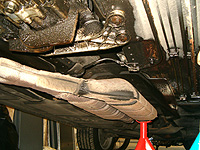
The lambda sensor, cable and the thin metal shield protecting the cable visible.
Undo the four 12 mm hex head nuts connecting the exhaust manifold with the front
exhaust pipes. A combination of a 1/2" 12 mm socket (6-point), 1/2" 250 mm socket
extension bar and a 1/2" 380 mm breaker bar.
Be aware! If the nuts are old there is a great probability that you will snap the
stud instead of get the nut free. If so, considering cracking the nuts or be at least
prepared to spend some hours getting the broken studs out of the exhaust manifold.

Exhaust manifold connected with a front exhaust pipe. Each pipe serves three cylinders.
Lowering the catalytic converter carefully using for example a jack. Then remove
the heat shield now visible after the catalytic converter has been removed. The heat
shield is fastened with six 13 mm hex head screws. Finally the driveshaft is visible!
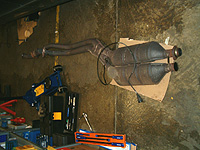
The catalytic converter together with the lambda sensor and cable removed.
In next part we start removing the driveshaft!
|

